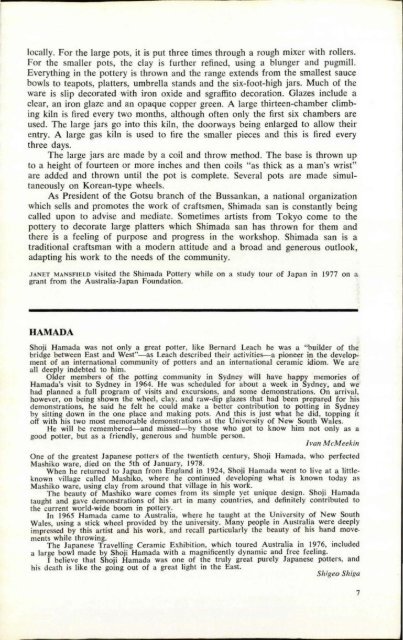Pottery in Australia Vol 17 No 1 Autumn 1978
Create successful ePaper yourself
Turn your PDF publications into a flip-book with our unique Google optimized e-Paper software.
locally. For the large pots, it is put three times through a rough mixer with rollers.<br />
For the smaller pots, the cl ay is further ref<strong>in</strong>ed, us<strong>in</strong>g a blunger and pugmill.<br />
Everyth<strong>in</strong>g <strong>in</strong> the pottery is thrown and the range extends from the smallest sauce<br />
bowls to teapots, platters, umbrella stands and the six-foot-high jars. Much of the<br />
ware is slip decorated with iron oxide and sgraffito decoration. Glazes <strong>in</strong>clude a<br />
clear, an iron glaze and an opaque copper green. A large thirteen-chamber climb<strong>in</strong>g<br />
kiln is fired every two months, although often only the first six chambers are<br />
used. The large jars go <strong>in</strong>to this kiln , the doorways be<strong>in</strong>g enlarged to allow their<br />
entry. A large gas kiln is used to fire the smaller pieces and this is fired every<br />
three days.<br />
The large jars are made by a coil and throw method. The base is thrown up<br />
to a height of fourteen or more <strong>in</strong>ches and then coils "as thick as a man's wrist"<br />
are added and thrown until the pot is complete. Several pots are made simultaneously<br />
on Korean-type wheels.<br />
As President of the Gotsu branch of the Bussankan, a national organization<br />
which sells and promotes the work of craftsmen, Shimada san is constantly he<strong>in</strong>g<br />
called upon to advise and mediate. Sometimes artists from Tokyo come to the<br />
pottery to decorate large platters which Shimada san has thrown for them and<br />
there is a feel<strong>in</strong>g of purpose and progress <strong>in</strong> the workshop. Shimada san is a<br />
traditional craftsman with a modern attitude and a broad and generous outlook,<br />
adapt<strong>in</strong>g his work to the needs of the community.<br />
JANET MANSFIELD visited the Shimada <strong>Pottery</strong> while on a study tour of Ja pan <strong>in</strong> 1977 on a<br />
grant from the <strong>Australia</strong>-Japan Foundation.<br />
HAMADA<br />
Shoji Hamada was not only a great potter, like Bernard Leach he was a "builder of the<br />
bridge between East and West"--as Leach described tbeir activities-a pioneer <strong>in</strong> the development<br />
of an <strong>in</strong>ternational community of potters and an <strong>in</strong>ternational c.eramic idiom. We are<br />
all deeply <strong>in</strong>debted to him.<br />
Older members of the pott<strong>in</strong>g communilY <strong>in</strong> Sydney will have happy memories of<br />
Hamada's visit to Sydney <strong>in</strong> 1964. He was scheduled for about a week <strong>in</strong> Sydney. and we<br />
had planned a full program of visits and excursions, and some demonstrations. On arrival,<br />
however, on be<strong>in</strong>g shown the wheel, clay, and raw-dip glazes that had been prepared for his<br />
demonstrations, he said he felt he could make a better contribution to pott<strong>in</strong>g <strong>in</strong> Sydney<br />
by sitt<strong>in</strong>g down <strong>in</strong> the one place and mak<strong>in</strong>g pots. And this is just what he did, topp<strong>in</strong>g it<br />
off with his two most memorable demonslrations at the University of New South Wales.<br />
He will be remembered-and missed-by those who got to koow him not only as a<br />
good potter, but as a friendly, generous and humble person.<br />
/ VO II M cMeekill<br />
One of the greatest Japanese potters of the twentieth century, Shoji Hamada, who perfected<br />
Mashiko ware, died on the 5th of January, <strong>1978</strong>.<br />
When he returned to Japan from England <strong>in</strong> 1924, Shoji Hamada went to li ve at a littleknown<br />
village ca ll ed Mashiko, where he cont<strong>in</strong>ued develop<strong>in</strong>g what is known today as<br />
Mashiko ware, us<strong>in</strong>g clay from around that vi llage <strong>in</strong> his work.<br />
The beauty of Mashiko ware comes from its simple yet unique design. Shoji Hamada<br />
taught and gave demonstrations of his art <strong>in</strong> many countries, and def<strong>in</strong>itely contributed to<br />
the current world-wide boom <strong>in</strong> pottery.<br />
In 1965 Hamada came to <strong>Australia</strong>, where he taught at the University of New South<br />
Wales, us<strong>in</strong>g a stick wheel provided by the university. Many people <strong>in</strong> <strong>Australia</strong> were deepl y<br />
impressed by this artist and his work, and recall particula rl y the beauty of hIS hand move.<br />
ments while throw<strong>in</strong>g.<br />
The Japanese Travell<strong>in</strong>g Ceramic Exhibition, which toured <strong>Australia</strong> <strong>in</strong> 1976, <strong>in</strong>cluded<br />
a large bowl made by Shoji Hamada with a magnificently dynamic and free feel<strong>in</strong>g.<br />
, believe that Shoji Hamada was one of the truly great purely Ja panese potters, and<br />
hi s death is like the go<strong>in</strong>g out of a great light <strong>in</strong> the East.<br />
Shigeo Shiga<br />
7


















